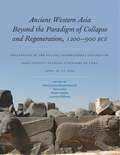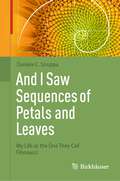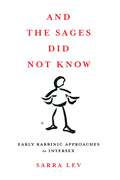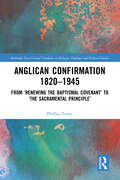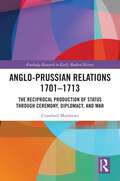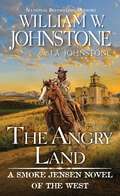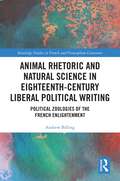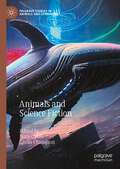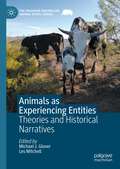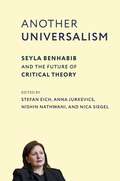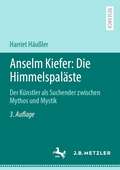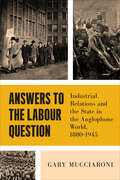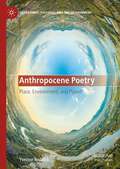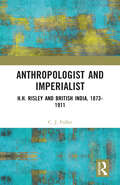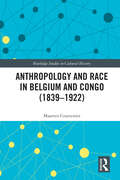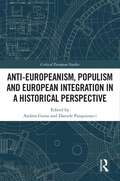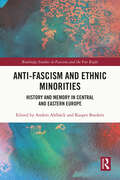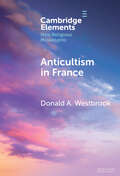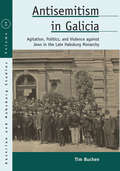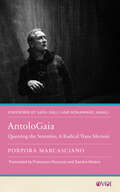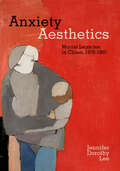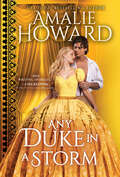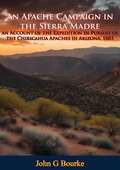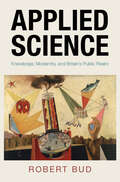- Table View
- List View
Ancient Western Asia Beyond the Paradigm of Collapse and Regeneration: Proceedings of the NYU-PSL International Colloquium, Paris Institut National d’Histoire de l’Art, April 16–17, 2019 (ISAW Monographs)
by Maria Grazia Masetti-Rouault, Ilaria Calini, Robert Hawley, and Lorenzo d’AlfonsoNew results and interpretations challenging the notion of a uniform, macroregional collapse throughout the Late Bronze Age Eastern MediterraneanAncient Western Asia Beyond the Paradigm of Collapse and Regeneration (1200–900 BCE) presents select essays originating in a two-year research collaboration between New York University and Paris Sciences et Lettres. The contributions here offer new results and interpretations of the processes and outcomes of the transition from the Late Bronze Age to the Iron Age in three broad regions: Anatolia, northern Mesopotamia, and the Levant. Together, these challenge the notion of a uniform, macroregional collapse throughout the Eastern Mediterranean, followed by the regeneration of political powers. Current research on newly discovered or reinterpreted textual and material evidence from Western Asia instead suggests that this transition was characterized by a diversity of local responses emerging from diverse environmental settings and culture complexes, as evident in the case studies collected here in history, archaeology, and art history. The editors avoid particularism by adopting a regional organization, with the aim of identifying and tracing similar processes and outcomes emerging locally across the three regions. Ultimately, this volume reimagines the Late Bronze–Iron Age transition as the emergence of a set of recursive processes and outcomes nested firmly in the local cultural interactions of western Asia before the beginning of the new, unifying era of Assyrian imperialism.
Ancient Worlds (DK Panorama)
by DKAncient Worlds is a tour through history's most influential civilizations between 3000 BCE and 600 CE, capturing in vivid detail moments that convey the cultural, technological, and organizational characteristics central to their success.From Sumer, the world's earliest civilization, to the heyday of the Mayan Empire, the tour crosses every continent, taking in developments in urban planning, art and architecture, religion, warfare, trade, and cultural exchange. Discover how deep knowledge of the Sun, sea, and stars enabled ancient seafarers to navigate the Pacific Ocean; witness the highs and lows of a thrilling chariot race in the Roman Empire's greatest hippodrome; and marvel at the military might of the Mauryan Empire and its 9,000 war elephants. Full of fascinating detail, each scene is a window on the lives of the most powerful and innovative peoples in times past. Ideal for children and parents to pore over together and explore similarities and differences with cultures around the world today.
And I Saw Sequences of Petals and Leaves: My Life as the One They Call Fibonacci
by Daniele C. StruppaIn this captivating historical novel, Daniele Struppa skillfully weaves a fictional autobiography, bringing Fibonacci to life with vivid details of his upbringing and adult years in Medieval Europe. As we explore the historical context of Fibonacci's time, we delve into the intriguing aspects of a bygone era, painting a compelling picture of a man whose contributions to mathematics continue to resonate today. From his groundbreaking work on congruent numbers to the famous numerical sequence that bears his name, the author invites readers to imagine the creative sparks that ignited Fibonacci's mathematical innovations. When historical evidence is elusive, accuracy and passion are seamlessly combined, offering plausible scenarios grounded in documented facts. A meticulously crafted apparatus of notes distinguishes fact from fiction, providing readers with a clear guide to navigate this enthralling reconstruction of Fibonacci's life. Step into the medieval world ofLeonardo Fibonacci, one of the most celebrated mathematicians in history, and discover the man behind the mathematical genius. Mathematicians and curious readers alike will appreciate the allure of Fibonacci's mathematical brilliance.
And the Sages Did Not Know: Early Rabbinic Approaches to Intersex
by Rabbi Sarra LevThis book explores the question: How did the rabbis of the first two centuries CE approach bodies that are born with variant genitals—bodies that they could not identify as definitely male or female? The rabbis had constructed a system in which every behavior was governed by one’s sex/gender, posing a conundrum both for people who did not fit into that model and for the rabbinic enterprise itself. Despite this, their texts contain dozens of references to intersex.And the Sages Did Not Know examines the rabbis’ legal texts and concludes that they had multiple approaches to intersex people. Sarra Lev analyzes seven different rabbinic responses to this conflict of their own making. Through their rulings on how intersex people should conduct themselves in multiple circumstances, the early rabbis treat intersex people as unidentifiable males or females, as indeterminate, as male, as non-gendered, as sui generis, as part-male/part-female, as a sustainable paradox, and, finally, as a way for them to think about gender, having nothing to do with intersex people themselves.This is the first such work that concentrates primarily on the potential effects of these rabbinic texts on intersex persons themselves rather than focusing on what the texts offer readers whose interest is rabbinic approaches to sex and gender or gender diversity. Although the rabbinic texts do not include the voices of known intersex people, these materials do offer us a window into how one small group of people approached intersex bodies, and how those approaches were both similar to and different from those we recognize today.
Anglican Confirmation 1820-1945: From ‘Renewing the Baptismal Covenant’ to ‘The Sacramental Principle’ (Routledge New Critical Thinking in Religion, Theology and Biblical Studies)
by Phillip ToveyThis book focuses on Anglican Confirmation in theology, liturgy, and practice from 1820 to 1945. This was a period of great change in the ways Anglicans approached Confirmation. The Tractarian movement transformed the Communion, and its ideas were carried overseas with the missionary movement. The study examines the development of a two-stage theology and its reception. It analyses the wave of liturgical revision expressed in England in the 1928 Prayer Book. It explores the episcopal changes in practice from the eighteenth-century paradigm to a new way of confirming. The revolution of the time has left a legacy that still informs practice, while doubts about theology and its liturgical application have left an existential crisis. The author reflects on how the current situation in various provinces has its roots in this period and the diffusion of ideas in the Communion. The book offers a fresh systematic examination of the neglected ecclesial practice of Confirmation, providing a more holistic view and clarifying developments to help us better understand the present. It will be of particular interest to scholars of Christian theology, liturgy, ecclesiology, and church history.
Anglo-Prussian Relations 1701–1713: The Reciprocal Production of Status through Ceremony, Diplomacy, and War (Routledge Research in Early Modern History)
by Crawford MatthewsIn 1701, Frederick I crowned himself the first King in Prussia. This title required a process of royal status construction in conjunction with other European rulers, and Frederick found his most willing partners in the English monarchy. This volume examines their ceremonial and military cooperation. Diplomatic ceremonial was the medium through which the English state and its representatives recognised the new royal rank of the Hohenzollern dynasty. In exchange, Frederick engaged in extensive military cooperation with the English in the War of the Spanish Succession. Yet English statesmen and diplomats also instrumentalised Anglo-Prussian relations for their own status production, furthering their careers and elevating their rank via the symbolic construction of Prussian royal dignity. This book investigates this reciprocal construction of status and rank, exploring the aims and actions of actors involved, and assessing the extent to which they succeeded. Consequently, this book represents an actor-centred work of ‘new diplomatic history’ that simultaneously reinterprets the reign of Frederick I and assesses a crucial yet understudied chapter in the rise of Prussia.This book will appeal to scholars and students of early modern diplomatic history, as well as general readers interested in the history of England and Prussia.
The Angry Land (A Smoke Jensen Novel of the West #6)
by William W. Johnstone J.A. JohnstoneWhen a cattle train bound for Texas is ambushed by blood thirsty rustlers, legendary mountain man Smoke Jensen vows to get the cattle back, get the killers who stole them—and get revenge for the blood they spilled . . . Johnstone Country. Where Outlaws Shoot. And Legends Shoot Back. The completion of a new railroad line from Colorado to Texas is a dream come true for Smoke Jensen and the other ranchers of Big Rock. But this dream turns into their worst nightmare when the first herd they load onto the train is stolen by a vicious gang of kill-crazy rustlers. This is no ordinary train robbery. It&’s an inferno of slaughter that includes the friendly rancher who volunteered to take Smoke&’s place on the trip. Now Smoke is saddling up and riding out—to get the prairie rats who murdered his friend . . . Smoke isn&’t the only one who&’s after these merciless killers. A pair of undercover lawmen from Texas have managed to infiltrate the gang by pretending to be dangerous outlaws. While Smoke is trying to track down the stolen herd, the undercover lawmen pretend to plot with the gang to rob more cattle trains. But there&’s a hitch in the lawmen&’s plan. To make sure they&’re really on board, the gang wants them to prove their loyalty—by eliminating their biggest threat: Smoke Jensen . . .
Animal Rhetoric and Natural Science in Eighteenth-Century Liberal Political Writing: Political Zoologies of the French Enlightenment (Routledge Studies in French and Francophone Literature)
by Andrew BillingOur tendency to read French Enlightenment political writing from a narrow disciplinary perspective has obscured the hybrid character of political philosophy, rhetoric, and natural science in the period. As Michèle Duchet and others have shown, French Enlightenment thinkers developed a philosophical anthropology to support new political norms and models. This book explores how five important eighteenth-century French political authors—Rousseau, Diderot, La Mettrie, Quesnay, and Rétif de La Bretonne—also constructed a "political zoology" in their philosophical and literary writings informed by animal references drawn from Enlightenment natural history, science, and physiology. Drawing on theoretical work by Derrida, Latour, de Fontenay, and others, it shows how these five authors signed on to the old rhetorical tradition of animal comparisons in political philosophy, which they renewed via the findings and speculations of contemporary science. Engaging with recent scholarship on Enlightenment political thought, it also explores the links between their political zoologies and their family resemblance as "liberal" political thinkers.
Animals and Science Fiction (Palgrave Studies in Animals and Literature)
by Nora Castle Giulia ChampionAnimals and Science Fiction is the first edited collection to be published focusing on the intersection of animal studies and science fiction studies. It offers a broad range of theoretical approaches and primary source texts—including novels, short stories, poetry, film and TV, photography, erotica, video games, and urban planning documents—that explore the ways works of science fiction can transform how we see and interact with nonhuman others. With an eye toward more just multispecies futures, it argues that speculative imaginaries can be pivotal in changing attitudes toward and understandings of nonhuman animals in our world today. Chapters appeal to those interested in biopolitics, posthumanism, new materialism, ecocriticism and the environmental humanities, ocean humanities, postcolonial studies, critical race studies, Indigenous studies, global sf studies, film studies, and food studies. Taken together, the collection works to showcase a diverse and growing field ofscholarly inquiry into animals and science fiction.
Animals as Experiencing Entities: Theories and Historical Narratives (The Palgrave Macmillan Animal Ethics Series)
by Michael J. Glover Les MitchellThis volume explores the experiences of those with little or no power—usually, although not exclusively, animals. The theme of animals as experiencing entities is what links the chapters and characterises the volume. Broadly each author in this volume contributes in one of two ways. The first group, in Section 1, theoretically engages animal subjectivity, animal experiences, and ways in which these are to some extent accessible and knowable to humans. The second group of authors, in Section 2, offer narrative accounts about specific animals or groups of animals and explore to some extent their subjective historical experiences. In summary, the first section diversely theorises about animal experiences, while the second section’s authors assume animals’ subjective experiences and construct narratives that take into account how animals might have subjectively experienced historical phenomena.
Another Universalism: Seyla Benhabib and the Future of Critical Theory (New Directions in Critical Theory #84)
by Stefan Eich, Anna Jurkevics, Nishin Nathwani, and Nica SiegelSeyla Benhabib’s ongoing work has expanded the range and scope of critical theory beyond its origins to address questions of gender, migration, and difference. This book brings together an ensemble of leading theorists and younger voices to explore new dimensions of Benhabib’s thought across critical theory, feminism, and democratic theory, foregrounding the intricate relationship between critique and universality.Another Universalism provides both a wide-ranging and comprehensive engagement with Benhabib’s path-breaking interventions and a panoramic tour of the cutting edge of critical theory today. Contributors take part in key debates about the field’s past and future, tackling subjects such as the relationship between democracy and cosmopolitanism, the role of law in emancipatory struggles, human domination of nature, the deprovincialization of critical theory concerning questions of race and empire, as well as Hannah Arendt’s continuing significance. Covering a wide range of debates and themes, Another Universalism is united by a core question: How can universal norms of human freedom, equality, and dignity be reconciled with particular contexts, especially ones of exclusion, difference, and adversity? Searching for universalisms that emerge from the concrete struggles of emancipatory movements, this book points toward an expansive, inclusive, and radical democratic vision.
Anselm Kiefer: Der Künstler als Suchender zwischen Mythos und Mystik
by Harriet HäußlerDie Untersuchung der Himmelspaläste, mit denen Anselm Kiefer sein skulpturales Werk begründet, eröffnet einen vollkommen neuartigen Zugang zum Oeuvre des Künstlers. Aus der Betrachtung des Skulpturenzyklus´ konnte die Erkenntnis gewonnen werden, dass Kiefer keineswegs vorrangig als ein deutscher Künstler der Nachkriegszeit verstanden werden kann, der in seinen Werken vornehmlich Trauerarbeit und Vergangenheitsbewältigung leistet. Vielmehr ist er als ein bewusst selbstreflexiv arbeitender, künstlerischer Künstler zu bezeichnen, der sich bereits Jahre vor seinem Umzug nach Frankreich mit zahlreichen komplexen Themen, die nicht den nationalen bzw. den germanischen Themengebieten zuzurechnen sind, intensiv auseinandergesetzt hat.Anselm Kiefers Kunst verkörpert für Kiefer ein Reflexionsmedium, mit dessen Hilfe er sich selbst in der Welt situiert. Das Verhältnis zwischen Mikro- und Makrokosmos findet eine Entsprechung in Kiefers Verhältnis zu seinem eigenen Werk. Dieser als paradoxzu bezeichnende Bezug ist von Distanz und Nähe zugleich geprägt.
Answers to the Labour Question: Industrial Relations and the State in the Anglophone World, 1880–1945 (Political Development: Comparative Perspectives)
by Gary MucciaroniSince the mid-nineteenth century, public officials, reformers, journalists, and other elites have referred to “the labour question.” The labour question was rooted in the system of wage labour that spread throughout much of Europe and its colonies and produced contending classes as industrialization unfolded. Answers to the Labour Question explores how the liberal state responded to workers’ demands that employers recognize trade unions as their legitimate representatives in their struggle for compensation and control over the workplace. Gary Mucciaroni examines five Anglophone nations – Australia, Canada, Great Britain, New Zealand, and the United States – whose differences are often overlooked in the literature on political economy, which lumps them together as liberal, “market-led” economies. Despite their many shared characteristics and common historical origins, these nations’ responses to the labour question diverged dramatically. Mucciaroni identifies the factors that explain why these nations developed such different industrial relations regimes and how the paths each nation took to the adoption of its regime reflected a different logic of institutional change. Drawing on newspaper accounts, parliamentary debates, and personal memoirs, among other sources, Answers to the Labour Question aims to understand the variety of state responses to industrial unrest and institutional change beyond the domain of industrial relations.
Anthropocene Poetry: Place, Environment, and Planet (Literatures, Cultures, and the Environment)
by Yvonne ReddickAnthropocene Poetry: Place, Environment and Planet argues that the idea of the Anthropocene is inspiring new possibilities for poetry. It can also change the way we read and interpret poems. If environmental poetry was once viewed as linked to place, this book shows how poets are now grappling with environmental issues from the local to the planetary: climate change and the extinction crisis, nuclear weapons and waste, plastic pollution and the petroleum industry. This book intervenes in debates about culture and science, traditional poetic form and experimental ecopoetics, to show how poets are collaborating with environmental scientists and joining environmental activist movements to respond to this time of crisis. From the canonical work of Ted Hughes and Seamus Heaney, to award-winning poets Alice Oswald, Pascale Petit, Kei Miller, and Karen McCarthy Woolf, this book explores major figures from the past alongside acclaimed contemporary voices. It reveals Seamus Heaney’s support for conservation causes and Ted Hughes’s astonishingly forward-thinking research on climate change; it discusses how Pascale Petit has given poetry to Extinction Rebellion and how Karen McCarthy Woolf set sail with scientists to write about plastic pollution. This book deploys research on five poetry archives in the UK, USA and Ireland, and the author’s insider insights into the commissioning processes and collaborative methods that shaped important contemporary poetry publications. Anthropocene Poetry finds that environmental poetry is flourishing in the face of ecological devastation. Such poetry speaks of the anxieties and dilemmas of our age, and searches for paths towards resilience and resistance.
Anthropologist and Imperialist: H.H. Risley and British India, 1873-1911
by C. J. FullerSir Herbert Hope Risley (1851 - 1911) - 'H. H. Risley', as he always signed himself - was a member of the Indian Civil Service (ICS) from 1873 to 1910 who served in Bengal and became a senior administrator and policymaker in the colonial government, as well as the pre-eminent anthropologist in British India. He was also an imperialist, who was convinced of the rightness of 'civilising' British rule and its benefits for both India and Britain, and one of this book's objectives is to render his simultaneous commitment to anthropology and imperialism intelligible to present-day readers. More specifically, Anthropologist and Imperialist: H. H. Risley and British India, 1873–1911 documents the two sides of Risley’s career, which is used as a case-study to investigate, first, the production and circulation of colonial knowledge, specifically anthropological knowledge, and secondly, its often loose and inconsistent connection with administration and policymaking, and with the government and state overall. Risley, like other officials engaged in anthropology in India, as well as the government itself, insisted that ethnography and anthropology had both ‘administrative’ and ‘scientific’ value; unlike previous works on Indian colonial anthropology, this book carefully examines its ‘scientific’ contributions in relation to contemporary metropolitan anthropology. It does not attempt to reinvent ‘greatman’ political or intellectual history, but does demonstrate the importance of studying the powerful officials who ruled British India, as well as the minor provincial politicians and subaltern subjects – or the abstract forces, such as colonialism and resistance – that have dominated recent historical scholarship. This book shows, too, that a detailed inquiry into Risley’s career, and his ideas and actions, can open new perspectives on a variety of continuing debates, including those over the colonial construction of caste and race in ‘traditional’ India, orientalism and forms of colonial knowledge, Victorian anthropology’s close relationship with the British empire, and the modern discipline’s uneasy links with its colonial past. Print edition not for sale in South Asia (India, Sri Lanka, Nepal, Bangladesh, Pakistan and Bhutan)
Anthropology and Race in Belgium and the Congo (Routledge Studies in Cultural History)
by Maarten CouttenierThis books examines the history of Belgian physical anthropology in the long nineteenth century and discusses how the notion of ‘race’ structured Belgian pasts and presents as well as relations between metropole and empire. In a context of competing European nationalisms, Belgian anthropologists mainly used physical characters, like skull form and the color of hair and eyes, to delimitate ‘races’, which were believed to be permanent and existent. Their belief in a supposed racial superiority was however above all telling about their own origins and physical characters. Although it is often assumed that these ideas were subsequently transferred to the colony, the case of Belgian colonization in Congo shows that colonial administrators, at least in theory, were reluctant to use the idea of permanent ‘races’ because they needed the possibility of ‘evolution’ to legitimize their actions as part of a ‘civilizing mission’. In reality, however, colonization was based on military occupation and economic exploitation, with devastating effects. This book analyzes how, in this violent context, widespread racial prejudices in fact dehumanized Congolese. This not only allowed colonizers to act inhuman but also reduced Congolese, or their body parts, to objects that could be measured, photographed, casted, and ‘collected’. This volume will be of use to students and scholars alike interested in social and cultural history as well as imperial and colonial history.
Anti-Europeanism, Populism and European Integration in a Historical Perspective (Critical European Studies)
by Andrea Guiso Daniele PasquinucciThis book explores the long-term origins of populist Euroscepticism.Taking a historical perspective to move beyond explaining present-day expressions of opposition to the European Union in isolation, this book reveals the historical sedimentation of the several ways and forms taken over decades by opposition towards European integration. As such, this approach – with contributions from across disciplines - explains not just the past of Euroscepticism, but also its current nature and future prospects.This book will be of key interest to scholars and students of European History, European Politics and Studies and more broadly to Political Science, International Relations, the Humanities and Social Sciences.
Anti-Fascism and Ethnic Minorities: History and Memory in Central and Eastern Europe (Routledge Studies in Fascism and the Far Right)
by Anders Ahlbäck Kasper BraskénAnti-Fascism and Ethnic Minorities explores how, and to what extent, fascist ultranationalism elicited an anti-fascist response among ethnic minority communities in Eastern and Central Europe. The edited volume analyses how identities related to class, ethnicity, gender and political ideologies were negotiated within and between minorities through confrontations with domestic and international fascism. By developing and expanding the study of Jewish anti-fascism and resistance to other minority responses, the book opens the field of anti-fascism studies for a broader comparative approach. The volume is thematically located in Central and Eastern Europe, cutting right across the continent from Finland in the North to Albania in the Southeast. The case studies in the fourteen research chapters are divided into five thematic sections, dealing with the issues of 1) minorities in borderlands and cross-border antifascism, 2) minorities navigating the ideological squeeze between communism and fascism, 3) the role of intellectuals in the defence of minority rights, 4) the anti-fascist resistance against fascist and Nazi occupation during World War II, as well as 5) the conflictual role ascribed to ethnicity in post-war memory politics and commemorations. The editors describe their intersectional approach to the analysis of ethnicity as a crucial category of analysis with regard to anti-fascist histories and memories. The book offers scholars and students valuable historical and comparative perspectives on minority studies, Jewish studies, borderland studies, and memory studies. It will appeal to those with an interest in the history of race and racism, fascism and anti-fascism, and Central and Eastern Europe.
Anticultism in France: Scientology, Religious Freedom, and the Future of New and Minority Religions (Elements in New Religious Movements)
by null Donald A. WestbrookThis Element introduces readers to the problem of anticultism and antireligious movements in France. The first section offers an overview of anticultism in France, including the paradoxical place of modern French secularism (laïcité) that has shaped a culture prejudiced against minority religions and new religions (sectes or 'cults') and impacted Europe more broadly. This includes state-sponsored expressions, in particular MIVILUDES, an organization funded by the French government to monitor cultic or sectarian deviances. The second section takes up the case of the American-born Church of Scientology, tracing its history in the country since the late 1950s and how it has become a major focus of anticultists in France. The Element concludes with reflections on the future of new and minority religions in France. A timeline provides major dates in the history of anticultism in modern French history, with a focus on items of relevance to Scientology in France.
Antisemitism in Galicia: Agitation, Politics, and Violence against Jews in the Late Habsburg Monarchy (Austrian and Habsburg Studies #29)
by Tim BuchenIn the last third of the nineteenth century, the discourse on the “Jewish question” in the Habsburg crownlands of Galicia changed fundamentally, as clerical and populist politicians emerged to denounce the Jewish assimilation and citizenship. This pioneering study investigates the interaction of agitation, violence, and politics against Jews on the periphery of the Danube monarchy. In its comprehensive analysis of the functions and limitations of propaganda, rumors, and mass media, it shows just how significant antisemitism was to the politics of coexistence among Christians and Jews on the eve of the Great War.
AntoloGaia: Queering the Seventies, A Radical Trans Memoir (Other Voices of Italy)
by Porpora MarcascianoIn this stirring memoir by a member of the first generation of LGBTQ+ activists in Italy, Porpora Marcasciano tells her story and shares the struggles and accomplishments of her fellow activists who achieved so much in the 1970s yet suffered devastating losses during the AIDS epidemic of the 1980s. AntoloGaia offers an insider’s look at the beginnings of the gay liberation movement in Italy and reveals how it was intimately intertwined with other forms of left-wing activism. At the same time, it powerfully conveys the queer joy of a young person from a small village first encountering the vibrant sexual minority communities of Naples, Bologna, and Rome. As Marcasciano starts to embrace her trans identity, she meets the famous anthropologist Pino Simonelli, who introduces her to Naples’s unique femminielli subculture and gives her the name Porporino, which she later shortens to Porpora. In keeping with this story of gender, sexual, and political discovery, AntoloGaia is the first piece of Italian life-writing to use gender-neutral and mixed-gender language.
Anxiety Aesthetics: Maoist Legacies in China, 1978–1985
by Jennifer Dorothy LeeAnxiety Aesthetics is the first book to consider a prehistory of contemporaneity in China through the emergent creative practices in the aftermath of the Mao era. Arguing that socialist residues underwrite contemporary Chinese art, complicating its theorization through Maoism, Jennifer Dorothy Lee traces a selection of historical events and controversies in late 1970s and early 1980s Beijing. Lee offers a fresh critical frame for doing symptomatic readings of protest ephemera and artistic interventions in the Beijing Spring social movement of 1978–80, while exploring the rhetoric of heated debates waged in institutional contexts prior to the '85 New Wave. Lee demonstrates how socialist aesthetic theories and structures continued to shape young artists' engagement with both space and selfhood and occupied the minds of figures looking to reform the nation. In magnifying this fleeting moment, Lee provides a new historical foundation for the unprecedented global exposure of contemporary Chinese art today.
Any Duke in a Storm (Daring Dukes #4)
by Amalie HowardHistorical romance takes to the high seas. Famed spy Lady Lisbeth Medford is on a ship bound for the West Indies, and the only thing more dangerous than her mission is the elusive Duke she's trying to capture.Lady Lisbeth Medford, Countess of Waterstone and famed international spy, is caught between the devil and the deep blue sea. She's determined to infiltrate a notorious smuggling ring in the West Indies while on a covert mission as a ship's captain. But even when her identity is compromised and she's forced to flee, the men chasing her are still hot on her heels.The trouble in front of her, however, might be even worse. Raphael Saint, the Duc de Viel, is her ship's new aggravating and dangerously charming sailing master, who might very well be part of the smuggling ring Lisbeth must bring to justice. But when a new deadly threat on the high seas looms, the only way out of danger is to face it…together.Praise for Amalie Howard:"Amalie Howard is the fresh voice historical romance needs right now. …Her prose is delightful, her writing masterful, her characters unforgettable... I will read every word she writes."—Kerrigan Byrne, USA Today bestselling author, for The Princess Stakes"Fiery chemistry...[with] fun action scenes of both the perilous and sexual varieties."—Kirkus Reviews for The Duke in Question"An adventurous romance...readers will not be disappointed."—Publishers Weekly for Rules for Heiresses
An Apache Campaign in the Sierra Madre: an Account of the Expedition in Pursuit of the Chiricahua Apaches in Arizona, 1883
by John G Bourke“With Crook in pursuit of Geronimo and his band.The author of this book was a U.S. soldier in addition to being a well known and highly regarded author on the Apache Wars of the later nineteenth century-in which he was an active participant. He maintained an interest, respect for and in some measure an affection for the Apaches and he also made a serious study of and wrote notable works on their customs and culture. He is perhaps best known for his classic account of the Apache Wars, 'On the Border with Crook.' This small account was written prior to his larger and more expansive work. It originally appeared as a series of articles in the Boston published 'Outing Magazine.' Bourke decided to bring his earlier writings back into print in book form, at a time when the Apaches had once again taken the war trail, to provide the American public with context to then current events. This fascinating account, which centres on the events of the Spring of 1883, concerns Crook's pursuit of the Chiricahua Apaches who broke out of San Carlos reservation to raid through Arizona and Mexico before vanishing into the fastness of the Sierra Madre. Those with any interest or knowledge in this subject will find themselves familiarly introduced to the corps of Apache Scouts, Al Sieber (Zieber), the scout and interpreter, Crook, Gatewood, Chato and of course the renowned Geronimo, as well as other names long associated with this remarkable time in the history of the Apaches and Arizona.”-Print ed.
Applied Science: Knowledge, Modernity, and Britain's Public Realm (Science in History)
by null Robert BudFor almost two centuries, the category of 'applied science' was widely taken to be both real and important. Then, its use faded. How could an entire category of science appear and disappear? By taking a longue durée approach to British attitudes across the nineteenth and twentieth centuries, Robert Bud explores the scientific and cultural trends that led to such a dramatic rise and fall. He traces the prospects and consequences that gave the term meaning, from its origins to its heyday as an elixir to cure many of the economic, cultural, and political ills of the UK, eventually overtaken by its competitor, 'technology'. Bud examines how 'applied science' was shaped by educational and research institutions, sociotechnical imaginaries, and political ideologies and explores the extent to which non-scientific lay opinion, mediated by politicians and newspapers, could become a driver in the classification of science.
